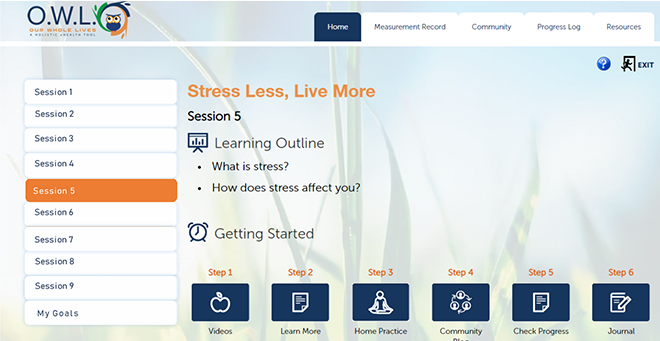
to nondrug treatments to diverse, low-income patients with chronic pain . |
A new study by integrated primary care researcher and physician Paula Gardiner, MD, finds that an interactive website can bring proven, effective nondrug treatments like mindfulness, meditation and yoga to chronic pain patients who may not otherwise have access to them. Published in the Journal for Medical Internet Research, the study found that participants who used the electronic health toolkit Our Whole Lives for Chronic Pain reported increased ability to deal with their pain. They also reported reductions in depression, pain interfering in their regular activities and the impact of pain on their overall quality of life, as well as a 13 percent reduction in use of opioid pain medications.
“There is a need for easy access to evidence-based nonpharmacological treatment options to help all patients with chronic pain. But many mobile phone health apps or websites have been designed for more affluent, highly educated people,” said Dr. Gardiner, associate professor of family medicine & community health and associate director of research and director of the Group Visits Program for the UMMS Center for Integrated Primary Care. “If you live in a low-income neighborhood, what options do you have for nondrug treatments in your neighborhood? We hypothesized that a mind-body chronic pain management platform that teaches self-management strategies could be an answer.”
The study was conducted at a Massachusetts safety net hospital where 70 percent of the patients live in a low-income neighborhood and 32 percent do not speak English as their primary language. The OWLCP website provided subjects with interactive self-monitoring of their pain, mood and medication use; self-directed instruction about nondrug pain interventions including mindfulness, movement and nutrition; a daily journal for personal reflection; and social support through its online community forum.
“Most amazing to me was that users of the website experienced a sense of community in that they were not alone in their pain and that others understood and had empathy for what they’re going through,” said Gardiner. “Even though they didn’t all meet face-to-face, they felt connected through exchanging messages on the community board.”
Patients also found that writing about how they were feeling using the website’s journal component helped them cope with their chronic pain. Especially significant was that pain impact, a measure of how chronic pain affects daily function, was significantly reduced in study subjects who stuck with the OWLCP program.
“Most mindfulness interventions studied have been in-person, so the fact we could find the same results using OWLCP is very promising. The other big finding is that low-income, low health literacy patients and those with health disparities can also benefit,” said Gardiner. “This gives us a bigger toolbox to use with patients. We’re trying to find opioid-free treatments and affordable treatments.”
All the OWLCP website content was informed by input from a racially diverse patient advisory group whose members all have chronic pain and live in low-income neighborhoods.
“What’s unique about OWLCP is that it was designed working with our target patient population and clinicians, not by computer techies without related personal and clinical experience” said Gardiner. “We also paid attention to patients’ different cultures. In the future it would be ideal to have different language versions with culturally sensitive variations.”
Gardiner and colleagues have submitted a funding proposal to the National Institutes of Health for a large, randomized clinical trial to further test the electronic toolkit’s usability and effectiveness by comparing it to a placebo or other non-app intervention.
Related story on UMassMedNow:
UMMS study finds group medical meetings help low-income patients with chronic pain, depression